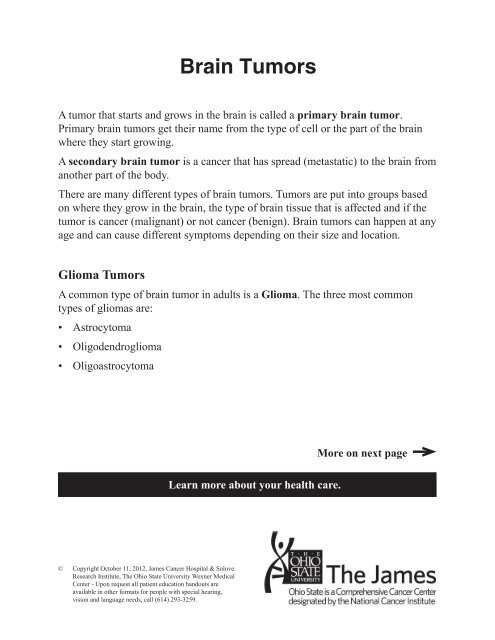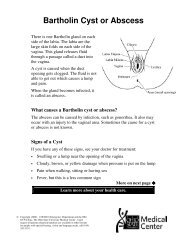Brain Tumors - Patient Education Home
Brain Tumors - Patient Education Home
Brain Tumors - Patient Education Home
You also want an ePaper? Increase the reach of your titles
YUMPU automatically turns print PDFs into web optimized ePapers that Google loves.
© Copyright October 11, 2012. James Cancer Hospital & Solove<br />
Research Institute, The Ohio State University Wexner Medical<br />
Center - Upon request all patient education handouts are<br />
available in other formats for people with special hearing,<br />
vision and language needs, call (614) 293-3259.<br />
<strong>Brain</strong> <strong>Tumors</strong><br />
A tumor that starts and grows in the brain is called a primary brain tumor.<br />
Primary brain tumors get their name from the type of cell or the part of the brain<br />
where they start growing.<br />
A secondary brain tumor is a cancer that has spread (metastatic) to the brain from<br />
another part of the body.<br />
There are many different types of brain tumors. <strong>Tumors</strong> are put into groups based<br />
on where they grow in the brain, the type of brain tissue that is affected and if the<br />
tumor is cancer (malignant) or not cancer (benign). <strong>Brain</strong> tumors can happen at any<br />
age and can cause different symptoms depending on their size and location.<br />
Glioma <strong>Tumors</strong><br />
A common type of brain tumor in adults is a Glioma. The three most common<br />
types of gliomas are:<br />
• Astrocytoma<br />
• Oligodendroglioma<br />
• Oligoastrocytoma<br />
Learn more about your health care.<br />
More on next page
<strong>Brain</strong> <strong>Tumors</strong>. Spanish.<br />
© Copyright October 11, 2012. James Cancer Hospital & Solove<br />
Research Institute, The Ohio State University Wexner Medical<br />
Center - Upon request all patient education handouts are<br />
available in other formats for people with special hearing,<br />
vision and language needs, call (614) 293-3259.<br />
Tumores cerebrales<br />
Un tumor que comienza y crece en el cerebro se llama tumor cerebral primario.<br />
Estos reciben su nombre del tipo de célula o la parte del cerebro en donde<br />
comienzan a crecer.<br />
Un tumor cerebral secundario es un cáncer que se ha propagado (metastásico) al<br />
cerebro desde otra parte del cuerpo.<br />
Hay muchos tipos diferentes de tumores cerebrales. Los tumores se clasifican<br />
en grupos basándose en el lugar en el que crecen en el cerebro, el tipo de tejido<br />
cerebral que afecta y si el tumor es cáncer (maligno) o no lo es (benigno). Los<br />
tumores cerebrales pueden aparecer a cualquier edad y pueden causar diferentes<br />
síntomas dependiendo de su tamaño y ubicación.<br />
Tumores tipo glioma<br />
Un tipo común de tumor de cerebro en adultos es un glioma. Los tres tipos más<br />
comunes de gliomas son:<br />
• Astrocitoma<br />
• Oligodendroglioma<br />
• Oligoastrocitoma<br />
Sigue en la próxima página<br />
Aprenda más sobre los cuidados de su salud.
2<br />
Glioma tumors develop roots that grow into the nearby normal brain tissue. The<br />
roots are unable to be seen with a MRI (Magnetic Resonance Imaging) or any other<br />
type of x-rays. Gliomas are unable to be cured with surgery because tumor cells<br />
that are not seen will remain after the tumor is removed. This type of tumor can<br />
spread to other areas of the brain. They rarely spread to other parts of the body.<br />
Treatment options for brain tumors may include: surgery, radiation or<br />
chemotherapy. Your doctor will talk with you about the type of treatment that is<br />
best for you.<br />
Grades of Gliomas<br />
<strong>Tumors</strong> are graded based on how the tumor cells look under a microscope. A piece<br />
of the tumor will be needed to determine the tumor grade. Grading is a system used<br />
to describe how abnormal or aggressive the tumor cells look. The lower the grade<br />
the more normal the tumor cells look. The higher the grade the more abnormal the<br />
cells look. With treatment, a brain tumor may grow back at some point in time.<br />
Types of Gliomas<br />
Astrocytoma<br />
Astrocytoma is the most common type of glioma. Astrocytomas are tumors<br />
that start in the “astrocytes” (star-shaped cells that make up the “glue-like” or<br />
supportive tissue of the brain).<br />
Grades of Astrocytoma tumors:<br />
• Grade I – Pilocytic Astrocytoma is an uncommon slow growing tumor that is<br />
found most often in children.<br />
• Grade II – Low Grade Astrocytoma is a low-grade glioma. This type of<br />
tumor usually affects younger adults. Although these tumors are low-grade<br />
and less aggressive, they can grow with or without treatment which may cause<br />
symptoms and harm to the brain.<br />
• Grade III – Anaplastic Astrocytoma is a high-grade tumor. This type of tumor<br />
grows faster and is more aggressive than grade II astrocytomas.
2<br />
Los tumores glioma desarrollan raíces que crecen cerca del tejido cerebral normal.<br />
Las raíces no se pueden ver con una resonancia magnética o cualquier otro tipo<br />
de radiografía. Los gliomas no pueden curarse con cirugía porque las células<br />
tumorales que no se ven permanecerán después de retirado el tumor. Este tipo de<br />
tumor puede propagarse a otras áreas del cerebro. Rara vez se propagan a otras<br />
partes del cuerpo.<br />
Las opciones de tratamiento para los tumores cerebrales pueden incluir: cirugía,<br />
radiación o quimioterapia. Su médico hablará con usted sobre el mejor tipo de<br />
tratamiento para usted.<br />
Grados de gliomas<br />
Los tumores se clasifican basándose en cómo se ven las células tumorales con el<br />
microscopio. Se necesitará un trozo de tumor para determinar el grado del tumor.<br />
La clasificación por grados es un sistema usado para describir qué tan anormales<br />
o agresivas se ven las células tumorales. Cuanto más bajo el grado, más normal<br />
se ven las células tumorales. Cuanto más alto el grado, más anormales se ven las<br />
células tumorales. Aun con el tratamiento, un tumor cerebral puede volver a crecer<br />
más adelante.<br />
Tipos de gliomas<br />
Astrocitoma<br />
El astrocitoma es el tipo más común de glioma. Los astrocitomas son tumores que<br />
comienzan en los “astrocitos” (células con forma de estrella que forman el tejido<br />
de soporte “como pegamento” del cerebro).<br />
Grados de tumores astrocitoma:<br />
• Grado I – El astrocitoma pilocítico es un tumor de crecimiento lento poco<br />
común que se encuentra con frecuencia en niños.<br />
• Grado II – El astrocitoma de bajo grado es un glioma de grado bajo. Este<br />
tipo de tumor generalmente afecta a adultos más jóvenes. Aunque estos tumores<br />
son de bajo grado y menos agresivos, pueden crecer con o sin tratamiento, lo<br />
que podría causar síntomas y dañar el cerebro.<br />
• Grado III – El astrocitoma anaplásico es un tumor de grado alto. Este tipo<br />
de tumor crece más rápidamente y es más agresivo que los astrocitomas de<br />
grado II.
3<br />
• Grade IV – Glioblastoma Multiforme (GBM) – This is the most common<br />
type of astrocytoma. This tumor can affect people of any age, but are most often<br />
found in older adults. It is a more aggressive and serious type of brain tumor.<br />
Treatment is needed to control the growth of the tumor.<br />
Oligodendroglioma<br />
An Oligodendroglioma brain tumor starts growing in the oligodendrocytes (cells<br />
that cover and protect the nerve cells in the brain and spinal cord).<br />
There are only two grades of Oligodendroglioma tumors:<br />
• Grade II Oligodendroglioma<br />
This type of tumor usually affects younger adults. Although these tumors are<br />
low-grade and less aggressive, they can grow with or without treatment which<br />
may cause symptoms and harm to the brain.<br />
• Grade III Anaplastic Oligodendroglioma<br />
This type of brain tumor is not common. It can develop at any age but it is most<br />
often found in middle-aged adults. This type of tumor is more aggressive and<br />
serious than lower grade tumors. Treatment is needed to control the growth of<br />
the tumor.<br />
Oligoastrocytoma<br />
An oligoastrocytoma is known as a “mixed” glioma brain tumor. It is made up of<br />
two types of cells, astrocytes and the oligodendrocyte These cells grow together<br />
and form this type of tumor.<br />
Talk to your doctor or others on your health care team if you have<br />
questions. You may request more written information from the Library for<br />
Health Information at (614) 293-3707 or email: health-info@osu.edu.
3<br />
• Grado IV– El glioblastoma multiforme (GBM) es el tipo más común de<br />
astrocitoma. Este tumor puede afectar a personas de cualquier edad, pero se<br />
encuentra con más frecuencia en adultos mayores. Es un tipo de tumor cerebral<br />
más agresivo y grave. Es necesario el tratamiento para controlar el crecimiento<br />
del tumor.<br />
Oligodendroglioma<br />
Un tumor cerebral oligodendroglioma comienza a crecer en el oligodendrocito (una<br />
célula que cubre y protege las células nerviosas del cerebro y la médula espinal).<br />
Existen solo dos grados de tumores oligodendroglioma:<br />
• Oligodendroglioma grado II<br />
Este tipo de tumor generalmente afecta a adultos más jóvenes. Aunque<br />
estos tumores son de grado bajo y menos agresivos, pueden crecer con o sin<br />
tratamiento, lo que podría causar síntomas y dañar el cerebro.<br />
• Oligodendroglioma anaplásico grado III<br />
Este tipo de tumor cerebral no es común. Se puede desarrollar a cualquier edad<br />
pero se encuentra con más frecuencia en adultos de mediana edad. Este tipo de<br />
tumor es más agresivo y grave que los tumores de menor grado. Es necesario el<br />
tratamiento para controlar el crecimiento del tumor.<br />
Oligoastrocitoma<br />
Un oligoastrocitoma se conoce como un tumor cerebral glioma “mixto”. Está<br />
compuesto de dos tipos de células, astrocitos y el oligodendrocito. Estas células<br />
crecen juntas y forman este tipo de tumor.<br />
Hable con su médico u otras personas de su equipo de cuidados de salud<br />
si tiene preguntas. Puede solicitar más información por escrito de la<br />
Biblioteca de Información de Salud llamando al (614) 293-3707 o por<br />
correo electrónico a: health-info@osu.edu.

















